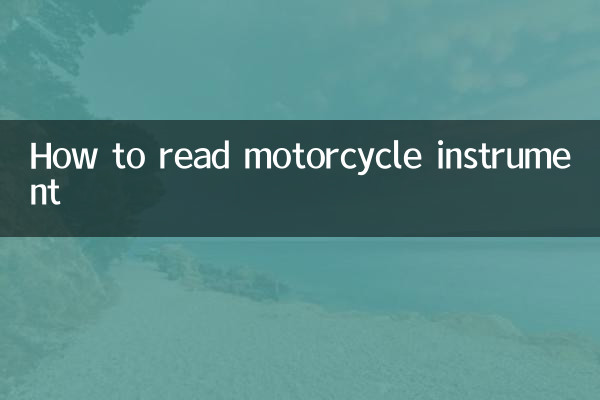What to think about motorcycle dashboard: Comprehensive analysis of dashboard functions and data interpretation
The motorcycle dashboard is an important window for riders to obtain vehicle status information. Correctly understanding the various data on the dashboard is crucial to safe riding. This article will combine the hot topics and hot content on the Internet in the past 10 days to provide you with a detailed analysis of the functions and data interpretation methods of motorcycle dashboards.
1. Basic components of motorcycle dashboard

| instrument area | Common display content | Function description |
|---|---|---|
| speedometer | Current speed (km/h or mph) | Displays real-time driving speed, and some models have speeding reminders |
| tachometer | Engine speed (RPM) | Displays revolutions per minute to help determine when to shift gears |
| fuel gauge | fuel remaining | Display the remaining fuel level through pointer or grid |
| Mileage display | Total mileage/single mileage | ODO is the total mileage, TRIP is the single mileage |
| warning light area | Various fault indicators | Including oil pressure, ABS, engine failure, etc. |
2. Detailed interpretation of dashboard data
1.The golden ratio of speed to rotational speed
Recent popular discussions show that many novice riders are confused about the matching relationship between rotational speed and vehicle speed. Ideally, ordinary street cars can obtain the best power and fuel economy by shifting gears at 6000-8000 rpm. The speed ranges of motorcycles with different displacements vary greatly. It is recommended to consult the vehicle manual for specific data.
| Displacement range | Economic speed range | red line speed |
|---|---|---|
| 125-250cc | 5000-7000RPM | 9000-10000RPM |
| 300-500cc | 4500-6500RPM | 8000-9500RPM |
| 600cc and above | 4000-6000RPM | 7500-9000RPM |
2.Fuel consumption and endurance calculation
The recent increase in oil prices has made fuel economy a hot topic. Through the fuel level display and TRIP mileage on the instrument panel, the actual fuel consumption can be calculated: clear the TRIP mileage after filling up → drive to the fuel gauge warning → record the mileage → use the fuel amount ÷ mileage × 100 = fuel consumption per 100 kilometers (L/100km).
3. Warning light identification and response
| warning light icon | color | meaning | Countermeasures |
|---|---|---|---|
| engine shape | yellow/red | engine failure | Stop the car immediately for inspection and contact maintenance |
| Oil can icon | red | Abnormal oil pressure | Turn off the engine immediately and check the oil level |
| ABS word | yellow | ABS system failure | Drive carefully and have it repaired as soon as possible |
| battery icon | red | Charging system failure | Check battery and charging circuit |
4. Analysis of new functions of smart meters
Many new cars released recently are equipped with full-color TFT instruments. These new instruments have the following popular functions:
1.Mobile phone Internet navigation screen projection- Support Apple CarPlay/Android Auto
2.Riding mode display- Clearly displays the current power mode (Sport/Standard/Rain)
3.Tire pressure monitoring display- Real-time display of front and rear tire pressure and temperature
4.Inclination recording function- Record the maximum inclination angle data during cornering
5. Tips for instrument maintenance
According to recent discussions on maintenance topics, common problems and maintenance suggestions for dashboards:
| Question type | Possible reasons | Solution |
|---|---|---|
| Blurred display | Surface scratches/internal fogging | Use special instrument to apply film/check sealing |
| Backlight is off | Damaged bulb/wire failure | Replace LED lamp bead/check wiring harness connection |
| Data bounce | Poor sensor contact | Clean speed/tach sensor contacts |
Correctly understanding motorcycle dashboard information can not only improve riding safety, but also help you better understand the status of your vehicle. It is recommended to regularly check the vehicle manual, participate in car owner training organized by the brand, and pay attention to any abnormal prompts on the dashboard. Through the detailed analysis of this article, I believe you have mastered the key points of motorcycle instruments. I wish you a happy riding!

check the details

check the details